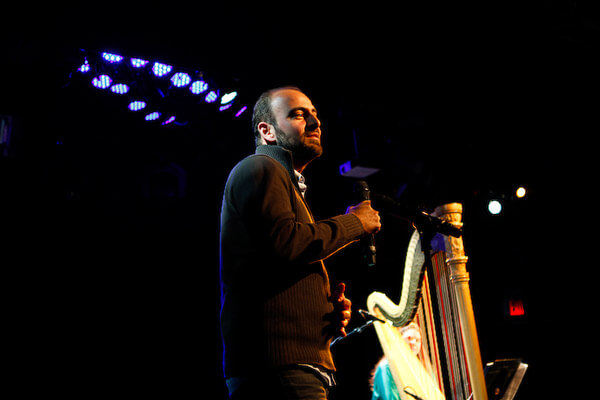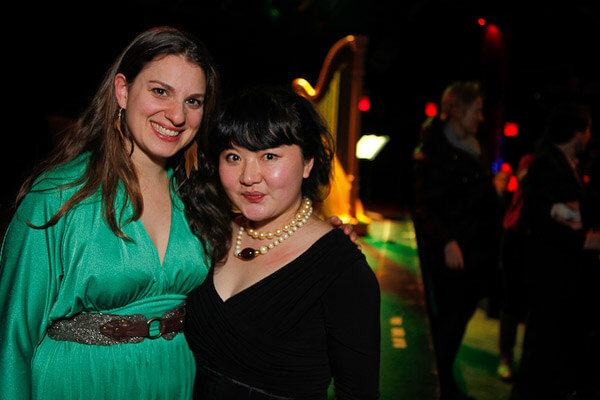 “Who’s ever been to a harp recital?” A couple of hands were shyly raised. “And who’s ever been to a harp recital in a club?” Bridget Kibbey had, in a few words, set the tone for the evening. Kibbey is one of the most talented harpists of her generation and her friendly, solar personality was at the center of this first installment in the Metropolis Ensemble’s Resident Artist Series, a series that will feature core ensemble artists as solo instrumentalists, collaborating with composers. The premises of Kibbey’s carte blanche made for a very intimate night: two years ago, Kibbey traveled to Brittany and discovered the active local Festoù-Noz (traditional night festivals) scene when she attended the Festival Interceltique de Lorient—France’s largest Celtic music festival. Traditions are still very much alive there, and Kibbey, inspired by the liveliness of Breton folklore and its potential to bridge generations, decided to arrange some reels and to invite composer friends born outside of the US to write music for this recital. The idea was to ask each composer to use their own folk heritage as a starting point, even though not all of them actually did.
“Who’s ever been to a harp recital?” A couple of hands were shyly raised. “And who’s ever been to a harp recital in a club?” Bridget Kibbey had, in a few words, set the tone for the evening. Kibbey is one of the most talented harpists of her generation and her friendly, solar personality was at the center of this first installment in the Metropolis Ensemble’s Resident Artist Series, a series that will feature core ensemble artists as solo instrumentalists, collaborating with composers. The premises of Kibbey’s carte blanche made for a very intimate night: two years ago, Kibbey traveled to Brittany and discovered the active local Festoù-Noz (traditional night festivals) scene when she attended the Festival Interceltique de Lorient—France’s largest Celtic music festival. Traditions are still very much alive there, and Kibbey, inspired by the liveliness of Breton folklore and its potential to bridge generations, decided to arrange some reels and to invite composer friends born outside of the US to write music for this recital. The idea was to ask each composer to use their own folk heritage as a starting point, even though not all of them actually did.

Indeed, some composers tried to embrace their native folk traditions while others opted for a looser approach. Kati Agócs was one of the former and Northern Lights, owes a lot to Canadian folk tunes: from À la claire fontaine, to I’s the B’ye the Newfoundland jig or the Huron Carol. Agócs’s used a variety of techniques including modal variations or structural distortions to make these pieces—that she had known for most of her life—her own. These three movements were placed in context by a prelude reminiscent of the church bell melodies one can hear in Montreal, and a postlude that used the harp’s resonance as a metaphor for Aurora Borealis, the Northern Lights.
Another colorful piece deeply imbued with folk tradition was David Bruce’s Caja de Música (Music Box, also the title of the concert). Even though Bruce was born in Connecticut and raised in England, his interest in world traditions led him to use elements of Joropo music from Venezuela for this commission. The result is an intense and joyful three-movement work, very tonal and rhythmic, displaying a feigned naivety. Paquito D’Rivera’s Bandoneon and Habanera were the other “Latin” pieces on the program, although they drew from different cultures: Habanera (dedicated to Maurice Ravel) is based on a rhythmic cell characteristic of Cuban music while Bandoneon is a homage to the instrument that is central in Argentinian tango music. D’Rivera and his assistant, Charles Whalen, adapted both pieces for harp, and specifically for Bridget Kibbey.
The customary laptop piece was brought to us by Ricardo Romaneiro: Glitch Box. Just like the title suggests, the sound of the live harp was mixed with noisy (as in signal noise) musical cells activated by the composer, present on stage in front of his computer. The result was not unlike what certain Björk tracks sound like on Vespertine (I think of Aurora in particular) until a deep house beat was heard, pretty much ruining what had been musically—and emotionally—built. Oh well.

Kinan Azmeh was invited on stage to introduce yet another club-inspired piece: It’s about time. Commissioned by Bridget Kibbey in 2011, It’s about time was initially meant to include elements of Syrian music but New York City’s electronica ended up being a stronger influence for Azmeh. The piece was short and riff-based, displaying interesting chromatic harmonies. Du Yun’s Ocean Within was organically complex and made use of uncommon techniques to conjure up astringent images: alternating minor seconds played with the pedals, tuning key used for glissandi, etc.

The program almost ended abruptly as the sound engineer was waving his flash light to Kibbey in exasperation: the room had to be cleared for a rockabilly event. Yes, there had been lots of speeches, thanks, and a sponsor plug but the Metropolis Ensemble was introducing a new concert series and kicking off the season. The burlesque could wait. Kibbey closed the evening as she opened it, with an arrangement of hers. Templehouse was a set of two Irish reels woven with grace, inventiveness, and dexterity that left one with a desire to hear more of Kibbey’s own music.
Metropolis Ensemble features first class performers and Bridget Kibbey is no exception. It was such a treat not only to hear her play, but to get an insight into her sources of inspiration and her creative/collaborative process.
To learn more about Metropolis Ensemble’s Resident Artists Series visit: http://www.metropolisensemble.org See also: http://www.bridgetkibbey.com
—
Thomas Deneuville, the founder and editor of I care if you listen, is a French-born composer living in NY. Find him on Twitter: @tonalfreak
























